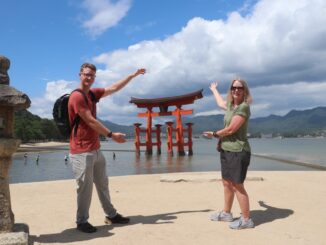HIROSHIMA, Japan – Once known more for its role in ending World War II, Hiroshima has now become a major tourist attraction, and each year thousands of visitors from Japan and around the world travel to this western Japanese city.
It was here at 8:15 a.m. on Aug. 6, 1945, during the closing weeks of World War II, that the first atomic bomb was dropped on a city. The blast produced a mushroom cloud and killed 140,000 people and left thousands more homeless. Three days later, the U.S. dropped a second bomb on Nagasaki, which killed an estimated 80,000 people, closing the chapter on the Second World War.
Walking through the city’s streets, it’s a bit eerie to think about what happened here and how the city has rebuilt. But, there’s no need to worry, as everyone in the city is exceptionally friendly, as demonstrated by schoolchildren on a class trip who revel in the opportunity to have their picture taken with Americans.
While atomic weapons no doubt remain a controversial subject, it is possible to take in Hiroshima and understand the historical significance of the city without spending too much time discussing the pros and cons of nuclear warfare.
For history buffs and travelers looking to see and understand what happened here, to Japan and to the whole world on that day, there are several memorials located in Peace Memorial Park in the center of the city near the bomb’s hypocenter and dedicated to the bombing – including the Peace Flame, which will not be extinguished until all atomic bombs are eliminated from the Earth.
The A-Bomb Dome, formerly the Hiroshima Prefecture Industrial Promotion Hall, was completed in April 1915, and was located near the bomb’s hypocenter. It is one of the few buildings to survive the blast. Historic photographs of the city show a landscape flattened by the blast, with just a few structures still standing – one being the shell of the Industrial Promotion Hall.
Another attraction, the Hiroshima Peace Memorial Museum, was built after World War II and is dedicated to the atomic bombing of the city and to the war. Though the museum presents history from a Japanese perspective, it includes exhibits and information detailing Japanese aggression throughout Asia leading up to World War II.
Hiroshima features a functioning streetcar system which takes travelers around the city. It may not be the fastest mode of transportation, but the streetcars connect Peace Memorial Park with the JR Hiroshima station, making these sites easily accessible from almost anywhere in Japan. At five hours, it is a long albeit worthwhile train ride from Tokyo.




